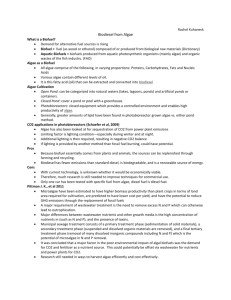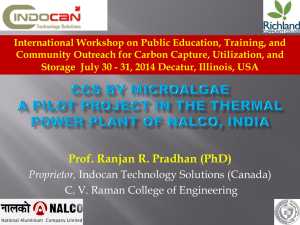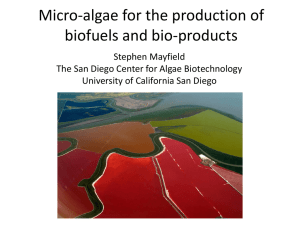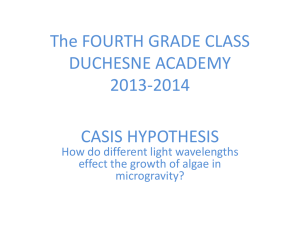Viability of Waste Utilization for Algae Production
advertisement
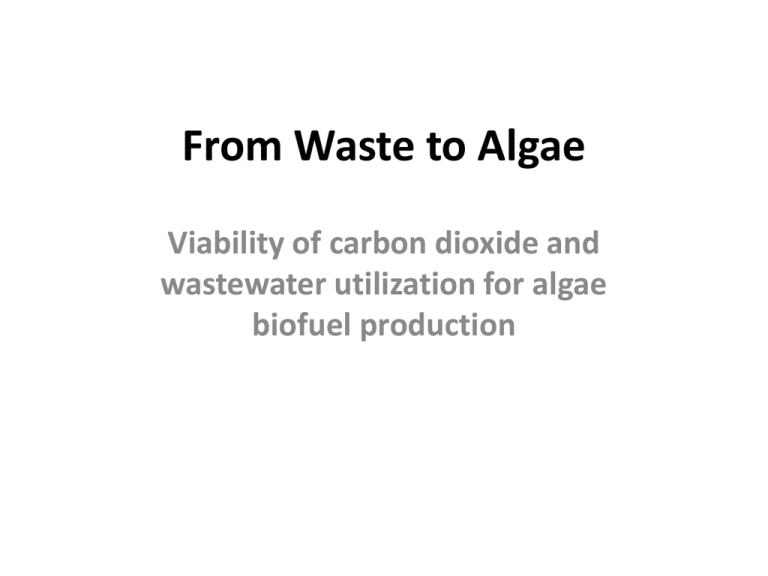
From Waste to Algae Viability of carbon dioxide and wastewater utilization for algae biofuel production Benefits of Using Algae • Efficient land use – Biomass produced per acre • Utilize marginal land • Removal of anthropogenic CO2 and certain water pollutants – Biological scrubber – Estimated over 65 Gt carbon per year – The amount of carbon produced by 65,000 – 500 MW generating plants Current Commercial Viability • Commercial algal biofuel production is not yet cost competitive – Crude oil $100/barrel – Algal biodiesel >$200/barrel • • • • Capital Cost Water and nutrients > 30% of cost Algae processing is energy intensive Algal biofuel as a co-product of waste management may be most cost effective – Wastewater as nutrient – CO2 increases productivity Factors in Algae Production • • • • Sunlight Temperature Carbon Dioxide Biological Competition Sunlight • Photosynthesis increases with increased sunlight – Solar saturation at 200 µmol/m2/s • Too much increases evaporative losses – California versus Virginia • 17% more land = 112% decrease in water use • Net evaporative losses were negative in Virginia Factors in Algae Production • • • • Sunlight Temperature Carbon Dioxide Biological Competition Temperature • Optimal temp 28-35°C – Varies with algal strain • University of Nevada – Cold tolerant strain • Ohio company – – use waste heat to grow year round Factors in Algae Production • • • • Sunlight Temperature Carbon Dioxide Biological Competition Carbon Dioxide Addition • Wastewater does not provide enough carbon • >30% increase in algae productivity in pilot plant • CO2 has been shown to help algae maintain pH – increases nutrient absorption CO2 Supply • Availability – Coal plants – 2,400 MMT/yr – Ethanol Plants – 25 MMT/yr • Cost of CO2 capture: – Coal - $21.23-90/tonne CO2 – Corn Ethanol - $6-12/tonne CO2 • Extra cost due to scrubbing and separation CO2 from Ethanol Fermentation • 1 gallon – 2.85 kg CO2 • 34.4 MMT/yr estimated 2020 • 2 tons algae fixes 1 ton CO2 Location of algae farm is important! • Transport cost: – $0.013 tonne CO2/km • Example: 1000 acre facility Virginia – Illinois to Virginia – 1163 km • $15 tonne/CO2 – CO2 fixation – 160 tonne/acre/year – $2.5 million year Factors in Algae Production • • • • Sunlight Temperature Carbon Dioxide Biological Competition Case # 1: Algae Combined with WWT • Reduces water footprint • Wastewater contains nutrients for algae cultivation • Urine is roughly 1% of flow volume – But provides 80% of Nitrogen and 50% of Phosphorus in wastewater • Nutrient removal accounts for 60-80% of energy use at WWT facilities • Excess N+P causes algal blooms Open Pond System • Requires more land than bioreactors • More efficient – 35 million kWh over 30 year lifespan Current Developments • • • • • Victor Valley, California Low-lipid algae – 45 g/m2/d Biogas through AD Electricity + Heat generation Capital investment recovery in 6.5 years – $800,000/yr energy costs Case #2: Integrated Biorefinery • Sioux City, Iowa – 50 mgy ethanol • 1,000 acre pond size – 60% CO2 abatement (100% at 2000 acres) • • • • 8.6 million gallons biodiesel $30/gallon 75% of operating costs -> heating Study did not address co-products – Biomass -> biogas -> heating Prospects to increase viability • Carbon tax – Increased investment • Carbon dioxide pipeline A Proposed CO2 Pipeline • Algae Corridor Conclusion • Currently, algae biofuel production is only viable on a local scale – WWTP for biogas -> electricity and heat • Significant capital investment will be required – Carbon Dioxide pipeline • Co-products may offer best future – Biomass -> biogas – Feed - $20,000/ton compared to $100/ton

